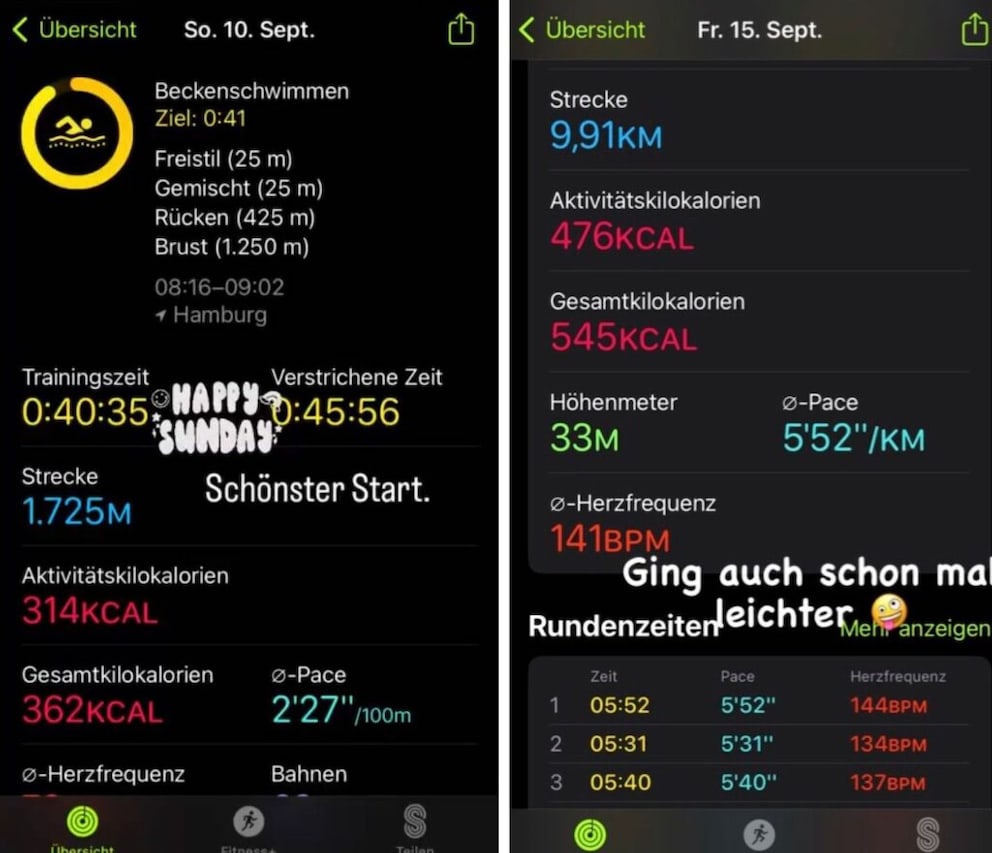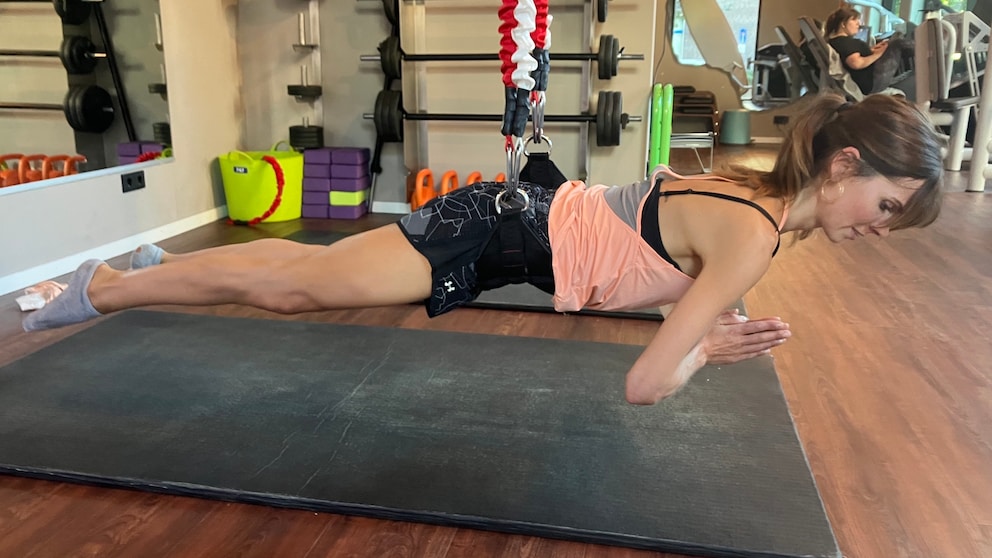April 12, 2025, 9:31 am | Read time: 9 minutes
Oh yes, the rest day … As a sports-mad recreational athlete, you often hear how important it is to have a day off training. Sometimes, much to the chagrin of those who train, as in the case of FITBOOK author Nina Ponath. Because she simply feels less balanced and focused without exercise, she ignored all the theories and tips for two weeks and simply did workouts every day. Here’s how she fared and what a doctor and a sports scientist had to say about it.
“I should actually do some sport again…” According to a survey by Techniker Krankenkasse, around 45% of people are self-confessed couch potatoes.1 I’m not one of them — which is not to say that I’m flawless when it comes to sport. On the contrary: “I should actually take a break again.” Or are so-called rest days for regeneration overrated? I did the self-experiment: two weeks of doing exercise every day without a day off in between.
Overview
“I Love to Get Moving First Thing in the Morning”
For me, sport is like brushing my teeth. It’s simply part of my daily routine. I usually exercise first thing in the morning, and immediately afterward, I have the feeling that I’ve “moved” something (I literally have), a positive priming effect that I take with me into the day.
I got into the habit of my morning exercise routine at my first job. Back then, I worked in an agency and had to sit a lot during the day — a maximum punishment for me — which is why I often went for a run with my dog in the morning. I was able to kill two birds with one stone at the same time because it meant I could get my walk done and get my exercise in.
I haven’t been tied to my desk for a long time now, and as an eleven-year-old pensioner, my dog only accompanies me on very slow or very short runs. Nevertheless, I still love to start my day with a run, a yoga session, or a short strength training session. While I’m training in the morning, I think about what I want to do and achieve during the day, which is why sport gives me stability, especially in very intense times. The last two weeks have been one of those times. Between what felt like a thousand articles, appointments, and trips, I often didn’t know where my head was at, so I decided to simply ignore the golden rule of “rest day is the best day” and train for two weeks in a row.
“What Happens If I Exercise Every Day for Two Weeks?”
Before I start my experiment, I set myself a few rules to prevent the whole thing from becoming too much, too obsessive, and too unhealthy:
- I only train when I really feel fit. This includes taking signs of a cold, severe tiredness, and feeling exhausted seriously.
- Because my body feeling is sometimes a bit … let’s say, “numb,” I train key values such as resting heart rate and heart rate variability with my fitness watch. If possible, both should remain relatively constant. (The former increases with too much exertion; the latter decreases with physical exertion and stress).
- I want to keep moving and not lose weight, gain weight, or set new records. In other words, I train in a way that feels good for me and don’t push my limits too much. A strenuous session is followed by a more relaxed workout, such as yoga or Pvolve.
2 Weeks of Daily Training: This Was My “plan”
To be honest, my plan for the two weeks was relatively haphazard. I simply trained in whatever way felt good to me. Sometimes it was a run with my dog in the morning, sometimes it was a quick run without him, followed by a walk or a round of strength training. If I trained intensively on one day, for example because I went for a fast or particularly long run, the next day I “only” went for a walk or a relaxed, slow swim. This way, the training didn’t feel forced, nor did I have a guilty conscience after the two weeks.

Week 1
The first week went without a hitch. I ran three times, swam once, and did strength training twice (I measured the latter as barre in my fitness app). I usually did sports in the morning, then worked for a few hours and took my dog out for a short walk in between. Because I burned around 1000 calories through exercise alone, I made sure I ate enough (an estimated 2400 to 3000 calories). In the evening, I was tired but not exhausted. I went to bed around 11 p.m. so that I would be fit again at 6 a.m. the next day.
Week 2
In the second week, I did more strength training and trained my upper body twice and my lower body twice. I also went for a very short run with my dog once (3 kilometers) and swam twice. I still felt fit. It was only in the middle of the week — when I had to travel to Leipzig for an article — that I was really exhausted in the evening. I don’t know whether it was because of all the training or the four-hour train journey. But after a good night’s sleep, everything was fine again the next day.
“What Two Weeks of Sport Has Done to My Body”
Do you lose weight, build muscle, and feel better in two weeks without a rest day? I have to disappoint you here: Relatively little has actually changed. I neither lost nor gained weight, which is probably due to the fact that I only skip exercise two days a week and also because I don’t have a car but do have a dog; I move around a lot in everyday life anyway. My daily calorie consumption over the two weeks was, therefore, no different than usual, according to the fitness bracelet. My resting heart rate (resting pulse) was a relaxed 45 to 48 beats per minute, which is also normal for me, and my heart rate variability fluctuated throughout the day from over 100 (after sport) to 40 (after sometimes very long Zoom sessions and the like).


Daily Exercise Without Rest Days — What the Experts Say
Daily Training Only Recommended to a Limited Extent
Andreas Heumann is a qualified sports scientist and personal trainer from Berlin. He is regularly recruited by film productions and celebrities when things need to happen very quickly. However, the sports expert only recommends daily training to a limited extent. “It all depends on what you want to achieve,” says Andreas. Basically, the “just sitting in the office” everyday life that many of us have is not the normal healthy state of a person, which is why daily exercise is not wrong.
Exercise with a Plan
However, if you have a specific goal, you should also plan your training. For example, if you want to improve your running, you could divide your training into one or two slower runs, a tempo run, and a long run. If you want to get stronger or build more muscle, you can train with a split. “I’m a fan of setting yourself a benchmark,” says Andreas. You can then train towards this and do regular de-loads — phases in which you only train half the amount or at a lower intensity.
The personal trainer himself does not require his clients to train every day. Instead, he recommends hard, smart sessions that work towards the respective goal. “I’m a fan of structuring your training and doing a de-load every few weeks.”
Vary Your Training
If you are simply exercising for the sake of exercise, Andreas advises you to vary your training so that you don’t overdo it. In his opinion, women like me have it good: they are much less likely to overtrain. On the other hand, women are more likely to get their hormones mixed up. “In women, over-intensive training combined with too much negative energy balance or too much dieting can lead to disruptions in the menstrual cycle.” Anyone who does more sport than usual should, therefore, eat enough.
Pay Attention to the Body’s Needs
With a two-week experiment, however, it is unlikely to get into such a state, says Andreas Heumann: “You would also notice this in your HRV and resting heart rate.” The important thing with such experiments is to pay attention to the body’s needs and take them seriously. In view of my “lack of planning,” changing the sports unit depending on how my body felt was, therefore, a good idea.
Fitness Level and Type of Sport Play a Role
“With something like this, it always depends on what level you’re at and what sport you’re doing,” says Prof. Dr. Karsten Hollander, Head Disciplinary Physician for Running/Walking at the German Athletics Association. The team sports doctor looks after numerous competitive athletes in athletics and skiing who are theoretically fit enough to do without breaks. “At this level, you can train twice a day for weeks without any problems,” says the doctor. “Interestingly, however, there are also nations like Kenya, who have won quite a few medals here today at the World Road Running Championships, and deliberately — also for religious reasons — almost always take a break on Sundays.” A rest day doesn’t seem to do any harm, even in competitive sports.

FITBOOK Author: “This Is What Happened When I did Exercise Every Day for 2 Weeks”

Before and After Comparison! How Natascha Ochsenknecht Lost Weight

7 Quick, Intensive Exercises for Defined Arms — Without Equipment
Exercise Is Good, but You Shouldn’t Overdo It Either
Exercise is natural for us humans. We are not made for long periods of sitting, which is why sport is a good idea. However, we shouldn’t overdo it, and if we exercise more often in phases, we should pay close attention to our body; this is the best indicator of whether we are doing ourselves harm or good. When exercising for a period of time, women should never do too much cardio training, as this can upset the hormones. If you are training for a specific goal, it is better to stick to a well-structured plan.

